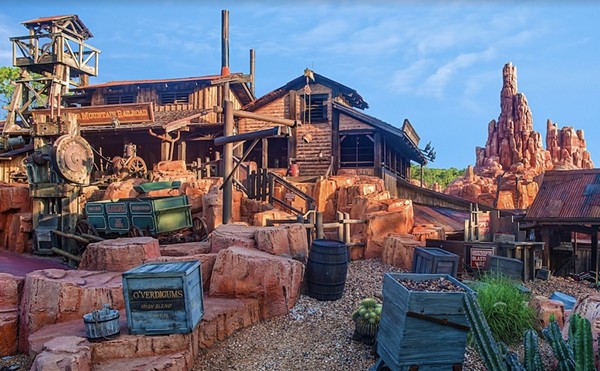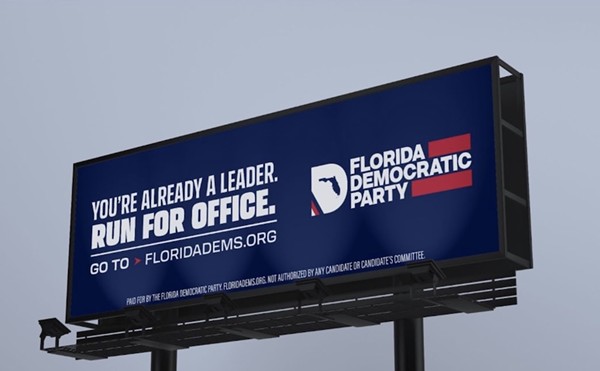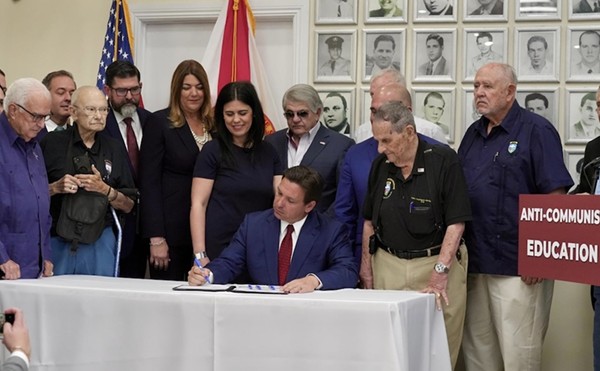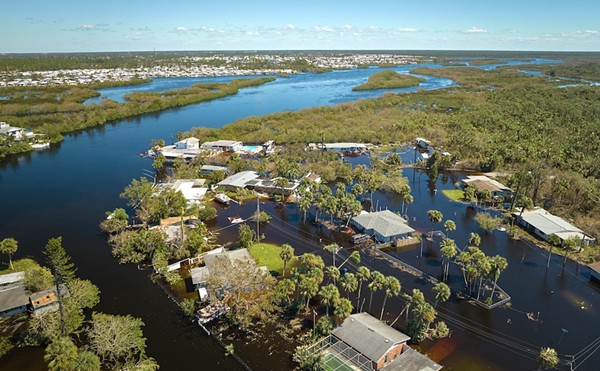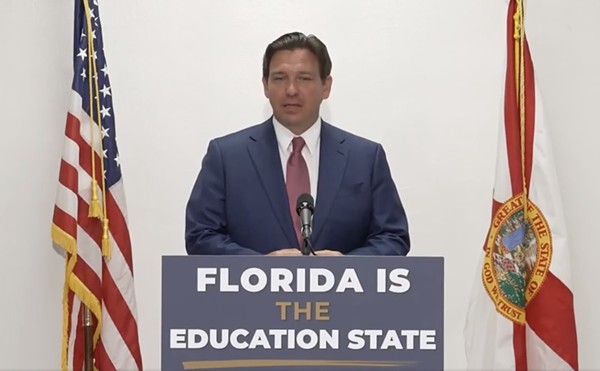John Mica has to be frustrated. Time and time again, the Republican Volusia County congressman has tried to push the region's leaders into thinking about rail as a means of alleviating congestion on I-4. He's even secured federal money to help out; but no one has jumped on board.
Why? Because rail is expensive, so much so that it might require raising taxes. And as Mobility 20/20's defeat two years ago demonstrated, Central Floridians are very quick to complain about I-4, but unlikely to raise taxes on themselves to do something about it.
Enter Mica, 2005. This year's plan is a commuter rail line running on CSX tracks from Volusia County to Poinciana, at a cost of $473 million. Half of the money would come from the feds, and a quarter would come from the state. The remainder, $118 million, would be divided by the four counties – Orange, Seminole, Osceola and Volusia.
But at a June 8 MetroPlan Orlando meeting, several Orange county commissioners said their $44 million share was too much, and would mean a tax hike. They gave preliminary approval for Mica to get the money from Washington – a "place saver," as county commissioner Bob Sindler called it – but rail in Central Florida appeared DOA again.
Even after Orange County and state Sen. Daniel Webster tentatively brokered an agreement that would cut local governments' contributions in half – to about $58 million to be split among the four counties – it's still not a done deal.
(Oddly enough, we already own the trains, purchased at a cost of $20 million split between the feds and local governments. If Mica's new plan falls flat, the hardware goes to Tri-Rail in South Florida.)
Does commuter rail have a chance this go-round? We asked Mica himself.
OW: Orange County commissioners don't seem too supportive of commuter rail. What's your take on the MetroPlan meeting?
Mica: Well, I was pleased that we had a unanimous vote, `and` at least at this stage, an approval. I am concerned about some of the comments about `their willingness` to participate in the future.
This isn't like we just brought this up yesterday. … `W`e've been testing alternate commuter rail and transit proposals since 1989. I just believe that everyone knows that the tooth fairy isn't going to pay the entire thing, and neither is the federal government. They were given a substantial proposal, which has 50 percent of the tab being paid by the federal government, 25 percent by the state, plus a bonus relieving them of all operational costs for at least four years, which is phenomenal by any standard. So for Central Florida to get into transit alternatives and be a participant like almost every other community of its size, they need to do it now.
OW: Five years ago we spoke to you when you were pushing a "demonstration" rail line on the CSX tracks. How is this proposal different?
Mica: Well, this is actually running. That was just a demo. I wanted to get the equipment and just starting running `it` as a demonstration.
This is a full operational system. It's taking it much further. We've actually demoed some of the equipment, and we will demo some of the latest equipment, tentatively set for July 11. The equipment's already been purchased that would run on this line. … `W`e were able to acquire the equipment, so we have the train – it's called a diesel multiple unit, which is a technical term for a self-propelled commuter rail car. … It's a dynamite piece of equipment. `T`hey've actually pulled double-decker rail cabs and they can haul close to 300 `people` just with a two-car configuration.
Environmentally, it beats anything on the road or rail. In fact, the cost savings on `the` fuel and operating – it literally pays for itself.
OW: County commissioner Bill Segal says this line is a "nonstarter" for him unless the freight trains that currently run on the CSX tracks are moved somewhere else. Is moving the freight trains feasible?
Mica: The state's picking up almost all the cost, I mean the total cost, of moving them out. It's going to be `gradual`. The first proposal is to take them off between, I think, 6 a.m. and 10 p.m. That may be expanded. …
`W`e've done this around the country. `We` did one, actually, in Dallas. It got most of our light rail money, and I've seen the way that one operates. And the commuter rail system actually makes money from the railroad for accessing the tracks that are now owned by the commuter rail system. It will evolve to, I think, a very positive effect for those communities.
Again, we'll have a passenger rail service to `serve` commuters, and we won't have mile-long trains blocking intersections at rush hour, so it's going to do several things to help us.
OW: The early ridership estimate is 3,500 people a day. That's less than half of what an additional highway lane would hold. What benefit is there for Central Florida, considering the $118 million local governments will have to pony up?
Mica: That's low … we've had some criticism because it doesn't have more than one stop in Volusia `County`. … You have to start somewhere for a 55-mile system that would be expanded. We have some initial operating segments that we hope to get to service as many passengers and stations and then expand the routes as soon as possible.
They just did a light rail system in Houston, and `Rep.` Tom DeLay is – you know he and I disagree, we're from the conservative brand, but we disagree on mass transit – he blocked all of the `federal` rail funds for Houston, so they built the whole thing themselves. It's only seven miles, it doesn't go very far, but it's a huge success. I went out and rode it. And, my God, it was absolutely packed. It goes from the downtown area to their convention area. It was pretty awesome.
OW: So you think that once it's there, once it's established …
Mica: Yeah. … I've watched these projects around the country, and there's the question, "Well, I don't have a stop," or "There's not enough ridership," and the next thing that happens is people are arguing over, "I want a stop" and "We want extended service," and that becomes the new debate.
When you build these, like they built Tri-Rail in South Florida, which is often used as an example of having a slow start … it only went to the equivalent of, say, from West Palm Beach to north Dade `County`, and you had to get off and take a bus to downtown. We've now connected it in to the airport and the ridership increased last year 19 percent in one year, so as you extend these to intermodal facilities where people live and work, the ridership dramatically increases.
But there's no line in the entire country that is better suited rail-wise than the CSX line in Central Florida to have dramatic usage of a commuter rail system. Again, look at some of where it goes. It goes through Florida Hospital's area – there are `13,000 to 15,000` people that just work in that area. You can walk through and look at the license plates, the different counties they come from. … Florida Hospital's excited about it. They'll save money for building additional parking garages that cost them between `$8,000 and $12,000` a space to build.
OW: There are estimates that taxpayers will have to subsidize as much as 60 percent of the commuter rail line's operating costs. Do you agree with that estimate? If so, is that acceptable?
Mica: The first thing you've got to realize, it will probably be about 50 percent of the operating cost. Right now, if you just expanded buses … the county commission and partners pick up 100 percent of the loss. So if the fare box for Lynx only raises 50 percent, then they pick `up the rest`.
With commuter rail, the state will pick up half of any of the fare-box losses. … Plus, `the state will pick up` property expenses the first four years. They said they'd pick up the whole thing. One hundred percent. … The buses are nice, but first off, they have a very high operating expense. If I have a 300-unit, two-car commuter rail, that's equivalent to … six bus drivers. And they're probably 40 grand apiece. `Commuter rail cars` have one operator. Not to mention fuel efficiency.
Then the biggest thing is you can actually get through a dedicated rail line. We do an express bus … from Volusia to downtown Orlando, and our major problem is buses get stuck in traffic along with the cars.
OW: Rail is generally discussed in the context of a much broader mass transit system, with the basic goal of taking people out of their cars.
Mica: Light rail. Light rail's important and we're probably going to have to build that from the I-Drive area to the airport, but commuter rail benefits the local commuters. You can use the existing infrastructure `the CSX tracks` which cuts your costs like 80, 85 percent.
OW: Do you see commuter rail as a sort of catalyst for improving the region's mass transit system?
Mica: Exactly. It's the beginning, it's sort of the spine to a regional system. It helps you utilize your buses, because you can use your buses in an east-west fashion and they can meet your commuter rail. And then, when you build your light rail, it would also be a feeder to light rail. It's sort of the spine to an entire regional system.
OW: It's been said that we support rail because we want to get other people off the roads.
Mica: That's true. Not everyone's going to use this. What's gonna happen? We've now expanded I-4 to eight lanes from about `State Road` 436, up in that area, to down toward Disney. Even in our most aggressive future development, we're only going to add four more lanes – which is two in each direction – so we'll only have two more directional lanes. As you know, in the morning going west is a nightmare and reverse traffic in the evening, so it's not that much improvement in capacity.
My point is, even when we finish it, whether it's 10 lanes total or 12 lanes, it's still gonna be bumper to bumper. … Part of it's because we don't have that many north-south roads, so there's just no place else to go; that's why this will be a good alternative. But it's not going to be for everyone, there's no question about that.
OW: Orange County commissioners have said that building the commuter rail, at least with the $44 million price tag, would mean a tax increase, and that would mean putting it to voters via a referendum. What would you say to voters to convince them that a project like this is worth spending their money?
Mica: I think if they put this on as a referendum it would pass. Last time with `Mobility` 20/20 it was confused with some other projects that I think were distasteful. … Is it better to pay 100 percent of your loss of fare box? Is it better to buy buses that will be stuck in north-south traffic, and pay a premium for operating them, as opposed to a more efficient, economical, environmentally friendly `rail line that will` get people through the traffic?
OW: Has it become more difficult to ask your colleagues to support rail projects for Central Florida, given that local leaders tend to turn them down?
Mica: Let me say it's been a gradual rehabilitation of our credibility. You know, you have to work at it every day. Because again, you know, there are dozens of communities vying for these projects. Many of them have passed the referendums in support. Dade just passed another one. They had a failure and then they passed it, so Dade's up in Washington asking for money, and they have a big local match. Charlotte; Portland, Ore.; San Diego; now Houston – I mean, the list goes on and on. We're gonna soon be one of the only major metropolitan areas in the entire United States without some sort of mass transit. It's hard to believe, but we may accomplish it.
OW: Five years ago, you said you were frustrated and that Congress wasn't going to keep offering money only to have locals reject it. Are you more optimistic this time around?
Mica: I'm more optimistic. But, you know, we still have – they have to secure the local support, and work with the folks. We'll do that. But I don't give up easily, if you know me.






